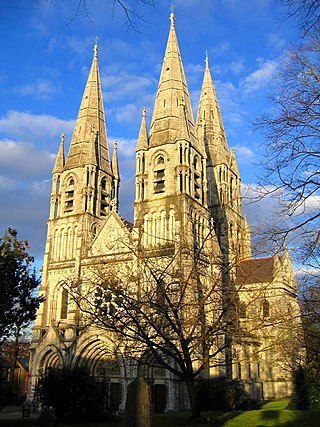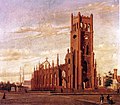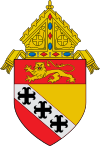
Saint Finbar, Finbarr, Finnbar, or Finnbarr, in Irish Fionnbharra, very often abbreviated to Barra, was Bishop of Cork and abbot of a monastery in what is now the city of Cork, Ireland. He is patron saint of the city and of the Diocese of Cork. His feast day is 25 September.

The Diocese of Charleston is a Latin Church ecclesiastical territory, or diocese, of the Catholic Church for the state of South Carolina in the United States. Currently, the diocese consists of 96 parishes and 21 missions, with Charleston as its see city. As of 2023, the bishop of Charleston is Jacques Fabre-Jeune.

The Diocese of Savannah is a Latin Church ecclesiastical territory, or diocese, of the Catholic Church in southern Georgia in the United States. The mother church of the diocese is Cathedral Basilica of Saint John the Baptist in Savannah. The patron saint is John the Baptist.

The Basilica-Cathedral of St. John the Baptist in St. John's, Newfoundland and Labrador is the metropolitan cathedral of the Roman Catholic Archdiocese of St. John's, Newfoundland and the mother church and symbol of Roman Catholicism in Newfoundland. The building sits within the St. John's Ecclesiastical District, a National Historic District of Canada.

John England was an Irish-born American prelate of the Catholic Church. He served as the first Bishop of Charleston, leading a diocese that then covered three Southern states. England previously served as a priest in Cork, Ireland, where he was active in the movement for Catholic emancipation in the British Isles. As bishop in Charleston, he ministered to and provided education for many free and enslaved African-Americans.

Patrick Neeson Lynch was an Irish-born prelate of the Roman Catholic Church. He served as bishop of the Diocese of Charleston in the Southeastern United States from 1857 until his death in 1882.

Patrick Charles Keely was an Irish-American architect based in Brooklyn, New York, and Providence, Rhode Island. He was a prolific designer of nearly 600 churches and hundreds of other institutional buildings for the Roman Catholic Church or Roman Catholic patrons in the eastern United States and Canada, particularly in New York City, Boston and Chicago in the later half of the 19th century. He designed every 19th-century Catholic cathedral in New England. Several other church and institutional architects began their careers in his firm.

The Cathedral of St. John the Baptist is the mother church of the Roman Catholic Diocese of Charleston, located in Charleston, South Carolina. Designed by Brooklyn architect Patrick Keely in the Gothic Revival style, it opened in 1907. The Most Reverend Jacques E. Fabre, the fourteenth Bishop of Charleston, was ordained and installed on May 13, 2022
Finbar is an Irish given name that may also be spelled Finbarr, Finbarre, or Finnbar. It is derived from Fionnbharr, an old Irish word meaning "fair-headed one". The anglicised, shortened translation of Finbar is Barry. Finbar may refer to:

Ambrose Maréchal, P.S.S. was a French-born Catholic prelate who served as Archbishop of Baltimore from 1817 until his death. He was a member of the Sulpicians.

John Moore was an Irish-born prelate of the Catholic Church. He served as the second bishop of the Diocese of St. Augustine in Florida from 1877 to 1901.

The Diocese of Limerick and Killaloe was a former diocese of the Church of Ireland that was located in mid-western Ireland. The diocese was formed by a merger of neighbouring dioceses in 1976, before itself merging with the neighbouring Diocese of Tuam in 2022 to form the Diocese of Tuam, Limerick and Killaloe.

St. Mary Help of Christians Church is a Catholic parish of the Roman Catholic Diocese of Charleston. The main parish church is at 138 Fairfield St. SE in Aiken, South Carolina. The campus also includes the historic 1905 church at the corner of Park Avenue and York Street, and Ste. Claire Chapel (1880), which sits to the left of the historic church. These two church buildings are listed on the National Register of Historic Places

The Cathedral of Saint Mary of the Assumption, colloquially known as Saint Mary's Cathedral, is a historic church located in Fall River, Massachusetts. It is the cathedral and a parish church in the Diocese of Fall River. Built from 1852 to 1856, the cathedral and adjacent rectory were added to the National Register of Historic Places in 1983, as St. Mary's Cathedral and Rectory. It is the oldest extant church building in the city of Fall River, and was one of the city's first Catholic parishes. The cathedral is dedicated to Mary, mother of Jesus under the title of Our Lady of the Assumption.

The Diocese of Cork, Cloyne and Ross, also referred to as the United Diocese of Cork, Cloyne and Ross, is a diocese in the Church of Ireland. The diocese is in the ecclesiastical province of Dublin. It is the see of the Bishop of Cork, Cloyne and Ross, the result of a combination of the bishoprics of Cork and Cloyne and Ross in 1583, the separation of Cork and Ross and Cloyne in 1660, and the re-combination of Cork and Ross and Cloyne in 1835.
TheCatholic Miscellany, successor to the U.S. Catholic Miscellany, the first Catholic newspaper in the United States, is the official newspaper of the Roman Catholic Diocese of Charleston. It was founded by Bishop John England, the first bishop of Charleston in 1822. He had been assigned to the area the previous year.

Ignatius Aloysius Reynolds was an American prelate of the Roman Catholic Church. He served as bishop of the Diocese of Charleston, covering three states in the American South, from 1844 until his death in 1855.

John James Joseph Monaghan was an American prelate of the Roman Catholic Church. He served as bishop of the Diocese of Wilmington in Delaware from 1897 to 1925.
Bishop William Coppinger (1753–1830) was an Irish Catholic priest, who served as Bishop of Cloyne and Ross, from 1791 until his death.

The Diocese of Tuam, Limerick and Killaloe is a diocese of the Church of Ireland that is located in the west of Ireland. The diocese was formed by a merger of the former Diocese of Tuam, Killala and Achonry and the former Diocese of Limerick and Killaloe in 2022, after the retirement of the separate dioceses' bishops and the appointment of Michael Burrows as bishop of the united diocese. It is in the ecclesiastical province of Dublin. It is one of the eleven Church of Ireland dioceses that cover the whole of Ireland. The largest diocese by area in the Church of Ireland, it covers all of counties Clare, Galway, Kerry, Limerick and Mayo, plus parts of counties Cork, Sligo, Roscommon, Offaly, Laois and Tipperary.




















